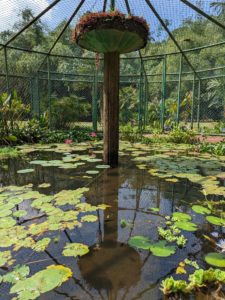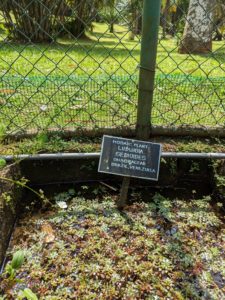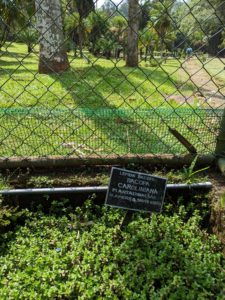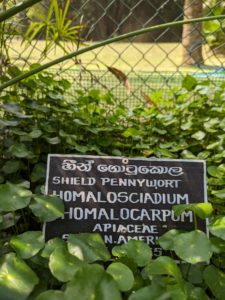The Royal Botanic Gardens at Peradeniya, just outside of Kandy in Sri Lanka, is a beautiful horticultural site and a highlight of a visit to central Sri Lanka.
Emersed plant house video tour – Royal Botanic Gardens, Sri Lanka
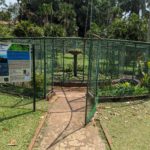
Of aquarium interest, the gardens feature an emersed-growth aquatic plants house, showcasing plants that grow with roots underwater and leaves above water. I’m trying (struggling) to have a go with emersed plants in the Shrimphaus, so this really got my attention. The house has a really nice layout with a pool featuring an central elevated platform, and a surrounding ring of individual species in a segmented formation.
Species include:
- Papyrus sedge – Cyprus papyrus
- Wild turmeric – Curcuma aromatica
- Water lettuce – Pistia stratiotes
- Amazon sword – Aquarius grisebachii
- Arrow leaf pondweed – Pontederia hastata
- Kohila – Lasia spinosa var araceae
- Stiff beargrass – Nomaphila stricta
- Slender knotweed – Persicaria decipiens
- Water fern (water sprite) – Ceratopteris thalictroides
- Water hyacinth – Pontederia crassipes
- Narrowleaf cattail – Typha angustifolia
- Golden leather fern – Acrostichum aureum
- Sweet flag – Acorus calamus
- Spadeleaf sword – Echinodorus cordifolius
- Mosaic Plant – Ludwigia sedioides
- Indian pennywort (water hyssop) – Bacopa monnieri
- Lemon bacopa – Bacopa caroliniana
- Swampweed – Hygrophila sp?
- Umbrella papyrus – Cyperus alternifolius
- Shield pennywort – Homalosciadium homalocarpum
- Ceylon balsam – Impatiens repens
- Sacred lotus – Nelumbo nucifera
- Yellow burrhead – Limnocharis flava
- Malayan sword – Lagenandra ovata
- Sri Lankan violet water lily (Dam-manel) – Nymphaea × erangae
Sri Lankan violet water lily – real identity
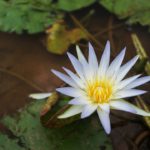
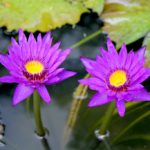
The blue water lily (Nymphaea nouchali) was declared the Sri Lankan national flower in 1986, but unfortunately was not identified with a representative photograph at that time. J.R. Jayewardene, the then president of Sri Lanka, sent out a photo of the violet water lily erroneously represented as Nymphaea nouchali leading to lasting confusion. Is it generally accepted that what people think of as the national flower of Sri Lanka is the violet water lily shown in picture sent by the president, even though the violet water lily is an invasive species and not Nymphaea nouchali at all. Modern molecular genetics has confirmed that the violet water lily is a hybrid cross between N. micrantha and N. caerulea now described as Nymphaea × erangae. It looks to me like the central pond of the emersed plant house in the Garden features the violet water lily.
Emersed plants of Sri Lanka available in the aquarium trade
Many of the emersed plants represented in the Royal Botanic Gardens are easily available for submersed and/or emersed aquarium growth. The various amazon swords are popular. Hygrophila of many different available varieties are well-known for rapid, easy growth in both high-tech (injected CO2) and low-tech (no injected CO2) planted aquarium setups. The pretty water sprite is something I’d like to try in either the Fireplace Aquarium or the Shrimphaus. Whilst the mosaic plant seems more popular for ponds and not for submersed growth, many other species of ludwigia will grow fully submersed. I might also like to give bacopa a try at some point, again, several different types are available. Cyperus alternifolius is not available for aquarium growth, but Cyperus helferi is. There are a lot of different pennyworts available, generally either Hydrocotyle verticillata or Hydrocotyle sibthorpioides; no sign of Homalosciadium homalocarpum, but then again, naming confusion in the trade is par for the course. Many different species of water lily and water lotus can also be found, again with some considerable confusion as to exact species names.
Outdoor vs indoor humidity
Kandy has a tropical rainforest climate with an average monthly humidity of 74% or higher which makes life easy for emersed leaves. In typical Sri Lankan architecture, there isn’t much of a difference between outdoor and indoor humidity with most buildings both freely open to the outside air and unheated. Cambridge has an oceanic climate which also maintains a reasonably high outdoor humidity level year-round actually not much different to the humidity levels in Kandy. The big difference though is that in winter, houses in Cambridge are heated. Our poorly insulated house for example has high levels of air exchange with the outside and when 5°C outdoor air at a typical 85% humidity for a Cambridge winter is heated to 20°C, the relative humidity falls to just over 30%. Emersed plant leaves don’t like that. True, there will be additional humidity in the microenvironment right over the water in the Shrimphaus, and respiration from the occupants of the house will add a little more humidity, most emersed plants from the topics will have a tough time making a go of it unless at least partially or fully enclosed so as to maintain higher humidity than in the house as a whole.
